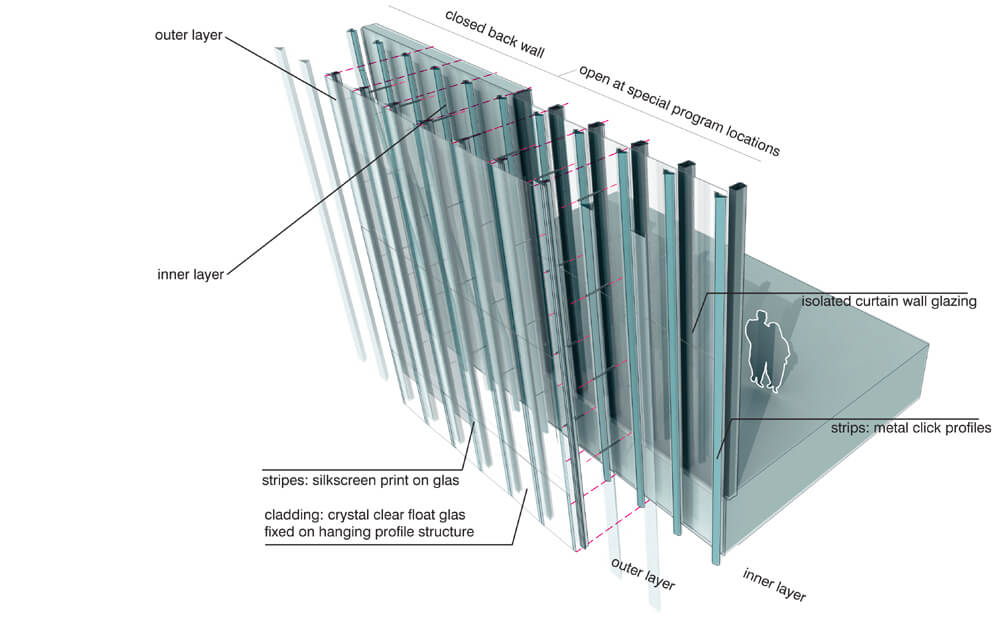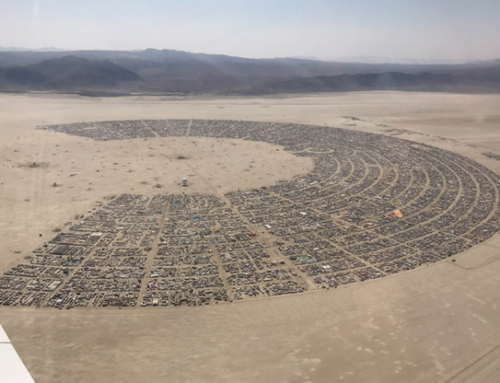Nominated for the Great Indoors Award, in 2011, the ”Galleria Centercity in Cheonan, South Korea is an exemplary demonstration of ‘kinetic’ facade in architecture. Boasting a media facade exterior of 12,600 m2, the Galleria Centercity is a private department store owned by conglomerate company Hanwha Stores — and is the largest luxury department store in the growing city of Cheonan in the Chung-cheongnam-do province. It was designed by “UN Studio”– an international architectural firm based in the Netherlands but with strong branches in Asia.
UN Studio has designed and constructed many public buildings in South Korea such as The Challenge Museum in Janghowon-eup, and apartment projects such as the Banpo Dong 7 Project in Seoul. Of these, UN Studio partnered with Hanwha Stores Co. in 2003 to redesign the “Galleria Department Store” in Apgujung-dong, Seoul. Similar to the media facade of Galleria Centercity in Cheonan, the Galleria Department Store consisted of “4330 glass discs’ ‘ on the “existing concrete skin of the building” – lit by LED lights to create a variety of multimedia effects. Writer Alice Liao details the 2003 Galleria department store design — calling the new remodeling a ‘makeover to better reflect the glamour of the galleria’s merchandise.1 The Seoul Galleria takes after the Centercity building and offers a sophisticated luxury retail experience–showcasing high end brands such as Chanel, Prada, Gucci, and Louis Vuitton. While the Seoul Galleria’s aesthetic now expands to both the exterior and interior designs, this wasn’t always the case. Before the 2003 redesign, Liao notes that the building had very little personality and even likened it to a “windowless concrete box.” 2 Working on the 2003 Seoul Galleria, lighting designer Rogier van der Heide, spoke on the new design, stating how he “wanted to embed the department store in the society of Seoul, “creating a revamped building that people talk about and respond to.”3 Indeed, the 2003 galleria remains one of the top examples of a light projection kinetic facade — as the building itself has become a tourist destination and a landmark for luxury brands.4
Architect Buckminster Fuller described kinetic facades as an extension of the idea that a building’s envelope is an active system rather than just a container.”5 Leading from this, kinetic facades can present an added meaning or message to the public, lending ourselves to further question or interpret the light facades created by Hanwha and UN studio. Additionally, department stores reflect a specific culture of luxury and consumption and it is interesting that designers accounted for the role department stores have in Asia as a place for exchange and socializing. From here, it is important to mention that department stores in South Korea have maintained primarily a wealthy consumer market — and as a result, those frequenting such galleria’s may not be representative of the broader population.
The role of department stores in the more luxury market in South Korea is noteworthy when considering the recent and ongoing remodeling of these stores. In the book, Global Luxury, authors Insoo Baek and Rika Fujioka highlight the position of Department Stores in South Korea — emphasizing how “department stores have also become main outlets for luxury goods and contributed to the expansion of the market’s target customer population.”6 While most high-end department stores now also carry a range of everyday affordable items, their targeted purpose remains to offer an exclusive/cosmopolitan experience marketed to wealthy consumers. The Galleria Department Store in Seoul was the “ first department store to build a luxury sales area, the ‘Luxury-Goods Hall’, an exclusive retail space for foreign luxury goods.”7 Following the Galleria Department store in 1990, Hyundai Department Store opened in the same neighborhood in Gangnam-gu, “selling imported luxury leather goods and clothing goods to wealthy consumers.”8
As writer Alice Liao stated, it does seem to be more fitting that a building containing top luxury brands presents itself to be just as glamorous and spectacular as its interior. The Galleria Centercity is a successful optical illusion, consisting of a 12,600 m2 facade produced by over 22,000 LED lighting points in “a shimmering skin that stands out impressively against its urban setting.” 9 Of the facade lighting projects Zumtobel — the lighting company co-designing the building — has completed, Galleria Centercity remains as their largest and most ambitious project.10 The facade seems to function entirely as the Galleria Centercity’s exterior– and has little functions related to the interior of the store. In the design of Galleria Centercity, UN Studio architect Ben van Berkel stated that “Shaping the shopping mall as a living space required, externally as well as internally, a unique, creative design force capable of attracting visitors, inviting them to linger and motivating them to return.” 11 Van Berkel continues to reference the role of department stores as a place for people to meet and gather.
Galleria Centercity poses as a unique and impressive landmark in Cheonan’s growing urban landscape. Given the cultural and social considerations, designers accounted for in the design, it is worth further considering or questioning the Galleria’s relationships with surrounding businesses, the local economy, and the broader community in the city.
References:
[1] Alice Liao, “An illuminated skin designed by Arup Lighting and UN Studio transforms The Galleria in Seoul,” Architectural Record. March 1, 2005, https://advance-lexis-com.proxy3.library.mcgill.ca/api/document?collection=news&id=urn:contentItem:4FPY-1VN0-TWJ5-H1VR-00000-00&context=1516831.
[2] Liao, “An illuminated skin designed by Arup Lighting and UN Studio transforms The Galleria in Seoul.”
[3] Liao, “An illuminated skin designed by Arup Lighting and UN Studio transforms The Galleria in Seoul.”
[4] “The mall’s new clothes: LEDs create a vibrantly colored fashion statement for the Galleria in Seoul,”Display & Design Ideas, July 2005. https://advance-lexis-com.proxy3.library.mcgill.ca/api/document?collection=news&id=urn:contentItem:4GR7-4F40-01CT-M0FM-00000-00&context=1516831.
[5] Designing Building Wiki, “Kinetic Facade,” last edited October 1, 2020, https://www.designingbuildings.co.uk/wiki/Kinetic_facade
[6] Insoo Baek and Rika Fujioka, “How Duty-Free Shops and Department Stores Expanded the Luxury Market in South Korea, 1980–2010,” in Global luxury: organizational change and emerging markets since the 1970s, ed Pierre-Yves Donze and Rika Fujioka (Singapore:Palgrave Macmillan), 162.
[7] Baek and Fujioka, “How Duty-Free Shops and Department Stores Expanded the Luxury Market in South Korea, 1980–2010,” 162
[8] Baek and Fujioka, 162.
[9] “Light extravaganza at Galleria Centercity,” July 2011- Press Release. https://www.zumtobel.com/media/downloads/PR_ZT-Cheonan_Galerie_Korea_EN.pdf
[10] Zumtobel, “Light extravaganza at Galleria Centercity,” July 2011, https://www.zumtobel.com/media/downloads/PR_ZT-Cheonan_Galerie_Korea_EN.pdf
[11] Zumtobel, “Light extravaganza at Galleria Centercity,” July 2011, https://www.zumtobel.com/media/downloads/PR_ZT-Cheonan_Galerie_Korea_EN.pdf
Image credit goes to UN Studio, Photo by Kim Jong-Kwan




